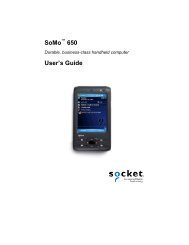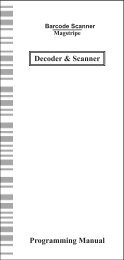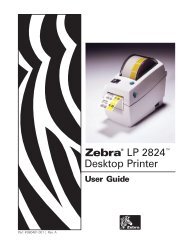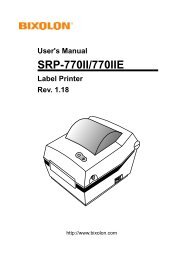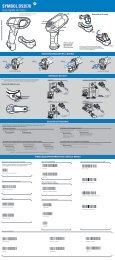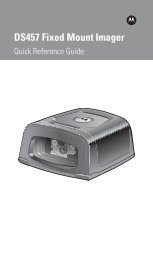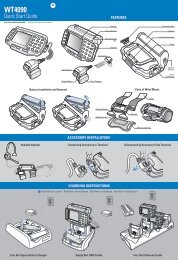Create successful ePaper yourself
Turn your PDF publications into a flip-book with our unique Google optimized e-Paper software.
V 1.6 1/11/2008<strong>PA600</strong><strong>Programming</strong> <strong>Manual</strong>
1. INTRODUCTION................................................................................................................. 61.1 How to download data from scanner ....................................................................................................................... 61.2 COM definition for <strong>PA600</strong>............................................................................................................................................ 72. USI.DLL – UNITECH SCANNER INTERFACE DLL........................................................... 82.1. Register the application to the USI DLL .................................................................................................................. 82.2. Unregister the application from the USI.DLL ....................................................................................................... 102.3. Enable / Disable Scanner........................................................................................................................................... 102.4. Reset Scanner .............................................................................................................................................................. 102.5. Get error code .............................................................................................................................................................. 102.6. Returns the system error code ................................................................................................................................102.7. Get scan data................................................................................................................................................................ 112.8. Get length of scanned data....................................................................................................................................... 122.9. Get Symbology name ................................................................................................................................................. 122.10. Clear scan data system buffer ............................................................................................................................. 132.11. Good read indicator ................................................................................................................................................ 132.12. Wait for acknowledgement of the last sent command .................................................................................. 132.13. Save setting to profiles .......................................................................................................................................... 132.14. Save scanner setting into specified file............................................................................................................. 142.15. Change scanner setting from specified setting profile ................................................................................. 142.16. Automatically enable scanner beam with pressing trigger key .................................................................. 142.17. Stop auto scanning function ................................................................................................................................142.18. Check if auto scanning is enable ........................................................................................................................ 142.19. Check if Scan2Key.exe program is running or not......................................................................................... 152.20. Test if Scan2Key is enabled.................................................................................................................................. 152.21. Load/Unload Scan2Key.exe.................................................................................................................................. 152.22. Enable/Disable Scan2Key ..................................................................................................................................... 152.23. Send scanner command to decoding chip....................................................................................................... 16- 2
2.24. Only send single command decoding chip ...................................................................................................... 162.25. Send command to decoding chip ....................................................................................................................... 162.26. Send scanner command set to decoding chip ................................................................................................ 172.27. Get scanner command set from decoding chip .............................................................................................. 172.28. Send scanner command set string to decoding chip .................................................................................... 172.29. Get scanner command set string from decoding chip .................................................................................. 182.30. Get scanner related version information........................................................................................................... 182.31. Enable prompt warming message from USI..................................................................................................... 182.32. Scanner working mode (available for 2D model) ............................................................................................ 182.33. Get image (available for 2D model)..................................................................................................................... 192.34. Resize image (available for 2D model)............................................................................................................... 192.35. Save image to file (available for 2D model) ...................................................................................................... 192.36. Get terminator .......................................................................................................................................................... 192.37. Set terminator........................................................................................................................................................... 202.38. Get good read sound mode and sound name ................................................................................................. 202.39. Set good read sound mode and sound name.................................................................................................. 202.40. Set previewsize (only for 2D engine).................................................................................................................. 202.41. Set previewsize time-out (only for 2D engine)................................................................................................. 202.42. Set good read sound mode and sound name.................................................................................................. 213. CONTROL COMMAND FOR DECODER CHIP................................................................ 224. SCANNER3.DLL – BACKWARD COMPATIBLE API FOR PT930/PT930S’SSCANNER3.DLL........................................................................................................................ 274.1. Enable Decoder............................................................................................................................................................ 274.2. Disable Decoder........................................................................................................................................................... 274.3. Check barcode input .................................................................................................................................................. 274.4. Read barcode data ...................................................................................................................................................... 284.5. Get DLL version no ..................................................................................................................................................... 284.6. Reset all symbologies to default ............................................................................................................................. 28- 3
1. Introduction1.1 How to download data from scannerThe major difference between the <strong>PA600</strong> and a standard HPC/PalmPC is barcode inputcapability. The WinCE Reference <strong>Manual</strong> contains no information regarding barcode input.This section will introduce the programming structure of the barcode sub-system and theprogramming utility library for the <strong>PA600</strong>. Inside the <strong>PA600</strong> there is an advanced decodingchip to control SE950 laser engine and to handle barcode decoding. Below is systemdiagram for the <strong>PA600</strong> barcode:SE950LaserEngineAdvancedDecoderChipCOM1CPUAccording to the above diagram, the <strong>PA600</strong> communicates with Decoder Chip by mean ofserial port COM4. Its communication parameter is fixed on 38400,N,8.1. Normally, theDecoder Chip is in sleep mode when COM4 is not activated. When COM4 is activated, theDecoder Chip will start working, and it will decode the barcode “signal” from the laser enginewhen the trigger key is pressed. After decoding, barcode data and its symbology type willbe sent directly to <strong>PA600</strong>.Many programmers find it difficult to control the Decoder Chip via programming languagealone, especially if they are not familiar with barcode and serial port controls. Because ofthis, <strong>Unitech</strong> provides the following utility library and program for the user or applicationprogrammer to control the Decoder Chip:1. Application program “Scan2Key.exe” is a useful application program that can readinput data from the laser scanner and then directly input the data into <strong>PA600</strong>’skeyboard buffer. “Scan2Key.exe” makes barcode data input simple, and can beespecially valuable to those programmers not familiar with COM port programming.User program simply reads the barcode data from the keyboard. For barcodesymbologies setting, you can run Scanner Setting from Control Panel to define all ofsupporting symbologies and delimiter.2. Utility library:For programming control, <strong>PA600</strong> provides USI.DLL to let user control scanner input,symbologies setting and profile controlling. Please refer to 2 for detail API lists.USI.DLL is <strong>Unitech</strong>’s new scanner function library on <strong>PA600</strong>. For backward compatibleissue, <strong>Unitech</strong> still provide Scanner3.DLL and ScanKey3.DLL for existingPT930/PT930SA user to port their software into <strong>PA600</strong>, but several APIs onScanner3.DLL and ScanKey3.DLL have already been removed on <strong>PA600</strong>. User canrefer to 0and 5 for detail supporting API.- 6
2. USI.DLL – <strong>Unitech</strong> Scanner Interface DLLNote : For <strong>PA600</strong> programming, it need to dynamically load DLL for using <strong>Unitech</strong> built-in DLL (<strong>Unitech</strong>will not provide *.H and *.LIB for compiler for mobile 5.0 OS), please refer to Chapter 8 forprogramming guide.2.1. Register the application to the USI DLLFunction Description:Register the application to the USI DLL, so that the DLL can communicate with the application. Itwill also open and initial scanner port (COM4, for example) and set the scanner to the workingmode. The application should call USI_Unregister to unregister from the DLL after done with thescanner.Function call:BOOL USI_Register(HWND hwnd, UINT msgID);Parameter: (input)hwnd: Handle of the window to which USI DLL will send messages to report all activities,including error messages, scan data ready, etc.msgID: Specifies the message to be posted. DLL will post messages by calling:PostMessage(hwnd, msgID, msg, param).The window procedure will receive custom message about msgID and wParam parametercan be one of the followings:SM_ERROR_SYSSM_ERRORIndicates a system error, which is caused by a call to the systemfunction. Param contains the error code from GetLastEror().Indicates an error. Param contains the cause of error, which canbe on of followings:SERR_INVALID_HWND Invalid window handle.SERR_INVALID_MSGID msgID cannot be 0.SERR_OPEN_SCANNER Open or initial scanner port failed.SERR_CHECKSUMChecksum error in received packet.SERR_DATALOSTNew scan data is lost because data buffer is notempty.SERR_BUFFEROVERFLOW Data buffer overflow. The default size is 4K bytes.SM_REPLYSM_DATAREADYSM_ACKSM_NAKSM_NOREADIndicates received a reply. All the responses from the scannerexcept the scan data will be notified by this message.Indicates that scan data is successfully decoded and ready toretrieve.Indicates received a ACK.Indicates received a NAK.Indicates received a No-Read packet.Note: Scanner port settings are defined in registry as described below:[HKEY_LOCAL_MACHINE\SOFTWARE\<strong>Unitech</strong> America Inc.\Scanner\Settings]"COMPORT"="COM4:""BAUDRATE"="38400""STOPBITS"="1""PARITY"="None""CHECKPARITY"="1"- 8
- 9
2.2. Unregister the application from the USI.DLLFunction Description:Unregister the application from the DLL. It will close the scanner port, and by default it will disablethe scanner.Function call:void USI_Unregister();2.3. Enable / Disable ScannerFunction Description:To start or stop USI function. This function is useful for application to temporarily stop scannerfunction if it is only need keypad input or keep clear input buffer.Function call:BOOL USI_EnableScan(BOOL bStatus);Parameter: (input)bStatus: TRUE : Enable ScannerFALSE : Disable ScannerReturn:BOOL : TRUE : OKFALSE : Failure2.4. Reset ScannerFunction Description:Set the scanner to the working mode, and reset the communication control.Function call:BOOL USI_Reset();Return:Always TRUE2.5. Get error codeFunction Description:Returns the error code (SERR_***).Function call:DWORD USI_GetError();Return:Returns the error code (SERR_***), which has been described in USI_Register function.2.6. Returns the system error codeFunction Description:Returns the system error code, which is returned by GetLastError. It will also return the descriptionof the error in buffer if it is not NULL.Function call:DWORD USI_GetLastSysError(LPTSTR buffer, int len);Return:Returns the system error code, which is returned by system function GetLastError. It will also returnthe description of the error in buffer retrieved by system function FormatMessage if it is not NULL.For a complete list of error codes, refer to the SDK header file WINERROR.H.-
2.7. Get scan dataFunction Description:Retrieves the scan data into the buffer. USI_GetData returns data in buffer in ASCII code, whileUSI_GetData2 returns in Unicode. Parameter len specifies the maximum length of the buffer.Returns the length of characters. It also returns the barcode type if type is not NULL. Return 0means that the buffer is too short to hold the data.The scanner will be disabled when scanner successfully decoded a data, so the data is protectedfrom been destroyed by trying continuously scanning. Call USI_GetData / USI_GetData2 orUSI_ResetData will automatically enable the scanner.USI_GetData should be called when SM_DATAREADY message is received. Or callUSI_ResetData to discard the data. Both of them will reset the data buffer and enable scanner, sothat next scan data can come in.If the data buffer is not empty and a new scan data occurs, it will be discarded and an errormessage SM_ERROR with code of SERR_DATALOST will be sent.For a complete list of barcode types, refer to the header file USI.H for the predefined data withBCT_ prefixFunction call:UINT USI_GetData(LPBYTE buffer, UINT len, UINT* type);UINT USI_GetData2(LPTSTR buffer, UINT len, UINT* type);Parameter: (input)len: UINT : Len specifies the maximum length of the buffer.Parameter: (output)buffer: LPBYTE : Data buffer for storing scanned datatype: UINT : barcode type which is defined on USI.H. Please refer to below listBCT_CODE_39 // Code 39BCT_CODABAR// CodaBarBCT_CODE_128 // Code 128BCT_INTERLEAVED_2OF5 // Interleaves 2 of 5BCT_CODE_93 // Code 93BCT_UPC_A// UPC ABCT_UPC_A_2SUPPS // UPC A with 2 SuppsBCT_UPC_A_5SUPPS // UPC A with 5 SuppsBCT_UPC_E0// UPC EBCT_UPC_E0_2SUPPS // UPC E with 2 SuppsBCT_UPC_E0_5SUPPS // UPC E with 5 SuppsBCT_EAN_8 // EAN 8BCT_EAN_8_2SUPPS // EAN 8 with 2 SuppsBCT_EAN_8_5SUPPS // EAN 8 with 5 SuppsBCT_EAN_13 // EAN 13BCT_EAN_13_2SUPPS // EAN 13 with 2 SuppsBCT_EAN_13_5SUPPS // EAN 13 with 5 SuppsBCT_MSI_PLESSEY// MSI PlesseyBCT_EAN_128 // EAN 128BCT_UPC_E1// UPC E1BCT_UPC_E1_2SUPPS // UPC E1 with 2 SuppsBCT_UPC_E1_5SUPPS // UPC E1 with 5 SuppsBCT_TRIOPTIC_CODE_39 // TRIOPTIC CODE 39BCT_BOOKLAND_EAN // Bookland EANBCT_COUPON_CODE // Coupon CodeBCT_STANDARD_2OF5 // Standard 2 of 5BCT_CODE_11_TELPEN // Code 11 TelpenBCT_CODE_32 // Code 32BCT_DELTA_CODE// Delta Code-
BCT_LABEL_CODEBCT_PLESSEY_CODEBCT_TOSHIBA_CODE// Label Code IV & V// Plessey Code// Toshiba Code China Postal CodeReturn:UINT: Data length2.8. Get length of scanned dataFunction Description:Returns the data length of the scan data. When allocate the memory to hold the scan data, add atleast one additional byte for string terminator.Function call:UINT USI_GetDataLength();Return:UNIT: Data length2.9. Get Symbology nameFunction Description:Returns the barcode name of the typeFunction call:LPCTSTR USI_GetBarcodeName(UINT type, LPBYTE buffer, UINT len);Parameter: (input)type: UINT : barcode type. (refer to below definition)buffer: LPBYTE : Please refer to below tableTypeBufferBCT_CODE_39 Code 39BCT_CODABARCodabarBCT_CODE_128 Code 128BCT_INTERLEAVED_2OF5 Interleaved 2 of 5BCT_CODE_93 Code 93BCT_UPC_AUPC ABCT_UPC_A_2SUPPSUPC A with 2 Supps.BCT_UPC_A_5SUPPSUPC A with 5 Supps.BCT_UPC_E0UPC EBCT_UPC_E0_2SUPPS UPC E with 2 Supps.BCT_UPC_E0_5SUPPS UPC E with 5 Supps.BCT_EAN_8 EAN 8BCT_EAN_8_2SUPPSEAN 8 with 2 Supps.BCT_EAN_8_5SUPPSEAN 8 with 5 Supps.BCT_EAN_13 EAN 13BCT_EAN_13_2SUPPSEAN 13 with 2 Supps.BCT_EAN_13_5SUPPSEAN 13 with 5 Supps.BCT_MSI_PLESSEYMSI PlesseyBCT_EAN_128 EAN 128BCT_TRIOPTIC_CODE_39 Trioptic Code 39BCT_BOOKLAND_EANBookland EANBCT_COUPON_CODECoupon CodeBCT_STANDARD_2OF5 Standard 2 of 5BCT_CODE_11_TELPEN Code 11 or TelpenBCT_CODE_32Code 32 (Pharmacy Code)BCT_DELTA_CODEDelta CodeBCT_LABEL_CODELabel Code IV & VBCT_PLESSEY_CODEPlessey CodeBCT_TOSHIBA_CODEToshiba Code (China Postal Code)-len: UINT : length of string on the 2nd parameter buffer
Return:BOOL : TRUEFALSE: OK: Failure2.10. Clear scan data system bufferFunction Description:Enable scanner and reset the data buffer so that next new scan data can come in.Function call:void USI_ResetData();2.11. Good read indicatorFunction Description:Inform a good receiving of scan data, this will play a sound (wave file scanok.wav) and light theLED lasting for 1 second.Function call:void USI_ReadOK();Note:USI will call the function GoodReadLEDOn function exported by the DLL defined in the registrydescribed below (UPI300.DLL is an example) to turn on and off the LED. If the DLL is not defined orthe function is not found, USI will bypass the call of GoodReadLEDOn.[HKEY_LOCAL_MACHINE\SOFTWARE\<strong>Unitech</strong> America Inc.\Scanner\Settings]"DLLLEDCONTROL"="UPI300.DLL"The function prototype of GoodReadLEDOn is:VOID WINAPI GoodReadLEDOn(BOOL fon);Turn on when fon is TRUE, and turn off when fon is FALSE.2.12. Wait for acknowledgement of the last sent commandFunction Description:Wait for acknowledgement of the last sent command until timeout. It is useful when a serial ofcommands needs to be sent at a time. Before call USI_SendCommand, callUSI_WaitForSendEchoTO to make sure that the previous command is done.Function call:BOOL USI_WaitForSendEchoTO(DWORD timeout);Parameter: (input)timeout: DWORD : Specifies the timeout in millisecond.Return:Returns FALSE if timeout.2.13. Save setting to profilesFunction Description:Save current settings of scanner so that the settings will be persistent when the unit get power offand on again.Function call:BOOL USI_SaveCurrentSettings();Return:TRUE if success, otherwise FALSE.-
2.14. Save scanner setting into specified fileFunction Description:Save the current settings to file. The file takes “*.USI" as extension name.Function call:BOOL USI_SaveSettingsToFile(LPCTSTR filename);Parameter: (input)filename: LPCTSTR : file name for setting profileReturn:TRUE = successFALSE = error2.15. Change scanner setting from specified setting profileFunction Description:Load and activate the settings from file.Function call:BOOL USI_LoadSettingsFromFile(LPCTSTR filename, BOOL formulaOnly);Parameter: (input)filename: LPCTSTR : name of scanner setting profile (*.USI)formulaOnly: BOOL : if TRUE, only data editing formulas are load. The other settingsremain unchangedReturn:TRUE = successFALSE = error2.16. Automatically enable scanner beam with pressing trigger keyFunction Description:Start auto scanning. Scan engine will be automatically triggerrd on.Function call:BOOL USI_StartAutoScan(DWORD interval);Parameter: (input)interval: DWORD : Specifies the interval in milli-secondNote:USI will call the function SetScannerOn function exported by the DLL defined in the registrydescribed below (UPI300.DLL is an example) to start and stop the scanner. If the DLL is notdefined or the function is not found, then auto scanning is not available.[HKEY_LOCAL_MACHINE\SOFTWARE\<strong>Unitech</strong> America Inc.\Scanner\Settings]"DLLSCANNERCONTROL"="UPI300.DLL"The function prototype of SetScannerOn is:VOID WINAPI SetScannerOn(BOOL fon);Start when fon is TRUE, and stop when fon is FALSE.2.17. Stop auto scanning functionFunction Description:Stop auto scanningFunction call:void USI_StopAutoScan();-2.18. Check if auto scanning is enableFunction Description:Check if auto scanning function is enabled or notFunction call:BOOL USI_IsAutoScanning();Return:BOOL: TRUE : auto-scanning is runningFALSE : auto-scanning is disabled.
2.19. Check if Scan2Key.exe program is running or notFunction Description:Test whether Scan2Key application is running at background. (It doesn't mean Scan2Key isrouting scanner input to keyboard, please call S2K_IsEnabled() to check if routing function isenable or not)Function call:HWND S2K_IsLoaded();Return:NULL: Scan2Key is not runningNon-NULL: indicates scan2key is running. It actually returns window handle for scan2key, butit is for internal use – send messages.2.20. Test if Scan2Key is enabledFunction Description:Test whether Scan2Key is enabled. Scan2Key routes scanning input from scanner to keypadbuffer, so that barcode data can be input as like from keystrokes on keypad.Function call:BOOL S2K_IsEnabled();Return:TRUE = enabled.FALSE = disable2.21. Load/Unload Scan2Key.exeFunction Description:Load or unload Scan2KeyFunction call:BOOL S2K_Load(BOOL load, DWORD timeout);Parameter: (input)load: BOOL : TRUE = load Scan2KeyFALSE = unload Scan2Keytimeout: DWORD : when unload Scan2Key, it will wait until Scan2Key has beenremoved from memory or timeout specified by this parameter.Return:TRUE = successfully loaded.2.22. Enable/Disable Scan2KeyFunction Description:Enable or disable Scan2Key to put scanned data to standard keyboard input buffer. Scan2Key isenabled by default.Function call:BOOL S2K_Enable(BOOL enable, DWORD timeout);Parameter: (input)enable: BOOL : TRUE = Enable scanned data to keyboard bufferFALSE = Disable scanned data to keyboardtimeout: DWORD : when enable or disable Scan2Key, it will wait until Scan2Key hasbeen removed from memory or timeout specified by this parameter.Return:TRUE = if successfully enabled Scan2Key, otherwise FALSE-
2.23. Send scanner command to decoding chipFunction Description:Send scanner command to decoder chip. This command will send a serial of bytes to decoder chipas following: (Esc and BCC will be calculated and added automatically)Esc, high-length, low-length, command-ID, operation, set, BCCPlease refer to complete command reference on section 4BOOL HAM_SendCommand(BYTE highlen, BYTE lowlen, BYTE cmdID, BYTE op, BYTE set);Parameter: (input)highlen: BYTE : high byte of command lengthlowlen: BYTE : low byte of command lengthcmdID: BYTE : command IDop: BYTE : operation mode for this commandset: BYTE : operand for this commandReturn:TRUE = Indicates the command has been successfully sent to queue to output.2.24. Only send single command decoding chipFunction Description:Send command to decoder chip. This is a variation of command HAM_SendCommand. It sendsfollowing command to Hamster: (note, only two bytes without BCC)Esc, 0x80+cmdFunction call:BOOL HAM_SendCommand1(BYTE cmd);Parameter: (input)cmd: BYTE : commandReturn:TRUE = indicates the command has been successfully sent to queue to output.2.25. Send command to decoding chipFunction Description:Send command to decoder chip. This is a variation of command HAM_SendCommand. It will reada number of parameters and packet them as in following format and send it to decoder chip.Esc, parameter1, parameter2, …, BCCThe total number of parameters is specified by first parameter num.Function call:BOOL HAM_SendCommand2(BYTE num, BYTE parameter1, …);Parameter: (input)num: BYTE : number of total parametersparameterx: BYTE : ParameterReturn:TRUE = indicates the command has been successfully sent to queue to output.-
2.26. Send scanner command set to decoding chipFunction Description:This function call has the same function as HAM_SendCommand except that it takes a singleWORD parameter for the length and an extra timeout parameter. This is a synchronized function, itreturns when command has been sent to and got response from scanner.USI_WaitForSendEchoTO is not needed before a next continuous send command call.To send a string please call HAM_SendCommand_SetString.BOOL HAM_SendCommand_Set(WORD len, BYTE cmdID, BYTE op, BYTE set, DWORD timeout)Parameter: (input)len: BYTE : Specifies length of command, which is actually always be 4.cmdID: BYTE : command IDop: BYTE : operation mode for this commandset: BYTE : operand for this commandtimeout: DWORD : Specifies the timeout in millisecondReturn:TRUE = indicates the setting has been set successfully.2.27. Get scanner command set from decoding chipFunction Description:This function call has the similar function as HAM_SendCommand_Set except that it retrievessetting from scanner. This is a synchronized function, it returns when command has been sent toand got response from scanner. USI_WaitForSendEchoTO is not needed before a next continuoussend command call.BOOL HAM_SendCommand_Get(WORD len, BYTE cmdID, BYTE op, BYTE* get, DWORDtimeout)Parameter: (input)len: BYTE : Specifies length of command, which is actually always be 4.cmdID: BYTE : command IDop: BYTE : operation mode for this commandget: BYTE* : Pointer to a byte which will hold the setting retrieved fromscanner.timeout: DWORD : Specifies the timeout in millisecondReturn:TRUE = indicates the setting has been retrieve successfully.2.28. Send scanner command set string to decoding chipFunction Description:This function call has the same function as HAM_SendCommand_Set except that it sends a serialof data instead of a single byte to scanner.BOOL HAM_SendCommand_SetString(WORD len, BYTE cmdID, BYTE op, LPCSTR sets, int slen,DWORD timeout)Parameter: (input)len: BYTE : Specifies length of command, which will be calculated andadjusted automaticallycmdID: BYTE : command IDop: BYTE : operation mode for this commandsets: LPCSTR : Specifies the string dataslen: int : Specifies the length of string data. Set to -1 to calculateautomaticallytimeout: DWORD : Specifies the timeout in millisecondReturn:TRUE = indicates the setting has been set successfully.-
2.29. Get scanner command set string from decoding chipFunction Description:This function call has the similar function as HAM_SendCommand_SetString except that it retrievessetting from scannerBOOL HAM_SendCommand_GetString(WORD len, BYTE cmdID, BYTE op, LPSTR gets, int* slen,DWORD timeout)Parameter: (input)len: BYTE : Specifies length of command, which will be calculated andadjusted automaticallycmdID: BYTE : command IDop: BYTE : operation mode for this commandgets: LPSTR : Buffer which will hold the setting retrieved from scannerslen: int* : Specifies the length of buffer and returns actual data length in thebuffertimeout: DWORD : Specifies the timeout in millisecondReturn:TRUE = indicates the setting has been retrieve successfully.2.30. Get scanner related version informationFunction Description:Get Scanner related version information. It does not need to call USI_Register to use this function.Function call:BOOL USI_GetScannerVersion(LPTSTR model, LPTSTR firmware, LPTSTR sdk, int blen);Parameter: (output)model: LPTSTR : scanner model.firmware: LPTSTR : firmware version number.sdk: LPTSTR : sdk version number if available.blen: int : specifies buffer length for parameters of model, firmware andsdk.Return:Always True.2.31. Enable prompt warming message from USIFunction Description:Enables USI to report working information in a popup windowFunction call:BOOL USI_EnablePromptMessage(BOOL enable);Parameter: (output)enable: BOOL : True= enable, Fail:DisableReturn:Always True.2.32. Scanner working mode (available for 2D model)Function Description:Sets scanner engine to working mode of barcode decoding/Image/Preview (mode =SWM_BARCODE) or image capture (mode = SWM_IMAGE) or preview and image capture (mode= SWM_IMAGE_PREVIEW) for 2D scannerFunction call:BOOL USI_SetWorkingMode(int mode);Parameter: (output)mode: int : mode = SWM_BARCODE – Barcodemode = SWM_IMAGE – image capturemode = SWM_IMAGE_PREVIEW – preview and image capturefor 2D scannerReturn:Always True.-
2.33. Get image (available for 2D model)Function Description:Retrieves captured image in bitmap format, and returns image size.Function call:HBITMAP USI_GetImageBitmap(SIZE* imagesize);Parameter: (output)imagesize: SIZE : Bitmap image sizeReturn:HBITMAP: image2.34. Resize image (available for 2D model)Function Description:Resizes a bitmap.Function call:HBITMAP USI_ResizeBitmap(HBITMAP hbmp, int cx, int cy, BOOL keepratio);Parameter: (input)hbmp: HBITMAP : the bitmap handle needs to be resized.cx: int: : cx define new width dimension of the bmp.cy int: : cy define new height dimension of the bmp.keepratio: BOOL: : If keepratio is true, it will resize the bmp to fit the cx-cyrectangle and keep the ratio of the original image.Return:HBITMAP: image2.35. Save image to file (available for 2D model)Function Description:Saves captured image to a file. The image format is determined by the file extension name, whichcan be .bmp, .jpg, .jpeg, .tif, .tiff or .raw. The compressionfactor is used for jpeg format.Function call:BOOL USI_SaveImageToFile(LPCTSTR filename, int compressionfactor);Parameter: (input)filename: LPCTSTR : File extension name defines format. HHP, SSIsupport .bmp, .jpg, and .tif. Tohken supports .bmp and .jpg.compressionfactor: int : compressionfactor is used for when format is jpg.Return:Always True.2.36. Get terminatorFunction Description:Returns terminator. The returned constant value is defined in USI_SetTerminator.Function call:int USI_GetTerminator();Return:Int: terminator-
2.37. Set terminatorFunction Description:Sets terminator.Function call:BOOL USI_SetTerminator(int terminator);Parameter: (input)terminator: int : TERMINATOR_ENTER : enter (CR/LF)TERMINATOR_RETURN : return (CR)TERMINATOR_LINEFEED : linefeed (LF)TERMINATOR_NONE : no terminatorReturn:Always True.TERMINATOR_ENTERENTER2.38. Get good read sound mode and sound nameFunction Description:Returns Good-Read-Echo mode and sound file name.Function call:int USI_GetGoodReadEcho(LPTSTR buffer, UINT blen);Parameter: (input)buffer: LPTSTR : returns sound file name which included pathblen: UINT : defines length of the buffer.Return:Int: GRE_PLAYSOUND : Play pre-set sound fileGRE_BEEP: Play default beep soundGRE_NONE: No sound.2.39. Set good read sound mode and sound nameFunction Description:Sets Good-Read-Echo mode and sound file name.Function call:BOOL USI_SetGoodReadEcho(int mode, LPTSTR SoundFileName);Parameter: (input)mode: int : GRE_PLAYSOUND : Play pre-set sound fileGRE_BEEP : Play default beep soundGRE_NONE : No sound.buffer: LPTSTR : sound file name which included pathReturn:It returns true when successful, false if mode is n/a.2.40. Set previewsize (only for 2D engine)Function Description:Defines how large is the window for image preview.Function call:void USI_SetPreviewSize (SIZE size);Parameter: (input)size: SIZE : Size of image preview window: double enter (CR/CR)2.41. Set previewsize time-out (only for 2D engine)Function Description:Set timeout for preview in seconds. When in taking image preview mode, this timeout will stoppreview and trigger to capture the image.Function call:void USI_SetPreviewTimeout (DWORD timeout);Parameter: (input)timeout: DWORD : timeout in seconds-
2.42. Set good read sound mode and sound nameFunction Description:Sets Good-Read-Echo mode and sound file name.Function call:BOOL USI_SetGoodReadEcho(int mode, LPTSTR SoundFileName);Parameter: (input)mode: int : GRE_PLAYSOUND : Play pre-set sound fileGRE_BEEP : Play default beep soundGRE_NONE : No sound.buffer: LPTSTR : sound file name which included pathReturn:It returns true when successful, false if mode is n/a.-
3. Control command for decoder chipImportant: This chapter describes low level command for scanner control function. If youalready USI to do scanner programming, you don’t need to care about this chapter. In general, itis not suggested to use level command to control scanner, because there are timing issue onserial communication programming , and it is always need communication expert to do that andit is hard to explain it on document.When Host prepare to send a command to hamster, it must first check CTS, if CTS is high, thenHost must set the RTS to high then clear RTS to low to wake up the Hamster.Special Command for controlcommand Format CommentControl Esc,80H+SOH(01H) Let Hamster enter slaving status. At this status Hamster justreceives commands and executes it until it receives Releasecommand or timeout (about 10s). Otherwise, the timeout isabout 1s as the interval of commands.Release Esc,80H+EOT(04H) Let Hamster exit from slaving status.Execute/ Esc,80H+ENQ(05H)EnquiryLet Hamster execute the previous saved command and checkhamster if there is a result of previous executed command tosend to Host. If previous saved command have alreadyexecuted and no result to send, hamster do not reply untilthere is a result. If Host receive a result but the BCC is wrong,it can re-send ENQ to re-send result again.ACK Esc,80H+ACK(06H) It is from Hamster to Host. If Hamster receive a command andthis command do not need send message back, Hamster replythe ACK.NAK Esc,80H+NAK(15H) It is from Hamster to Host. Hamster require the Host to re-sendcommand again, normally when received a wrong BCC, it cansend the NAK. The Hamster sends back NAK whenever itreceives a no sense command.COMMAND FROM HOST TO HMASTERCommand format:Esc,Lh,Ll,n,m,S1,...,Si,BCCHere: Esc is Escape code(H'1B)Lh/Ll is command's length when the Lh.b7 is 0, Lh is high byte, Ll is low byte, count from n to BCC.When Lh.b7=1 it is a two bytes special command.n is command IDm is operation: Normally for setting commands the 0 means setting, 1 default, 2 read current setting, 3special operation. When m=1 or 2, the S1 should be 0 for bits or one character setting. If the setting is astring, like pre_amble, the read or default command should not contain any Si byte. The special meaningin a command please refers the command definition.Si is setting/read data.BCC: it equals to XOR of all the bytes before the BCC.Conventions: S1.bj means the number j bit of byte S1.The expression 1~64:2 means that the number is between 1 and 64, the default is 2.Notice: Any interval in a command transmit can not exceed 1 second.Command Format CommentInitial/ Warm Esc,0,2,0,BCCstartDefault Esc,0,2,1,BCC Reset setting in RAM and initializeMpu_idle Esc,0,4,2,m,S1,BCC S1 is 0~3:0 is sleep mode,1 is watch mode,2_is standby mode.Hamster initializes the ports and flags according to the settingin RAM.-
Beep Esc,0,4,3,m,S1,BCC S1 0 none,1 low,2_medium,3 high,4 low/high,5high/lowblock_delay Esc,0,4,4,m,S1,BCC S1 is 0_10ms,1 50ms,2 100ms,3 500ms,4 1s,5 3schar_delay Esc,0,4,5,m,S1,BCC S1 is 0_none,1 1ms,2 5ms,3 10ms,4 20ms,5 50msFunction_codeCapslockLanguageBaud_rateParityData_bitsHandshakeAck_nakBCC_charData_directionTime_outEsc,0,4,6,m,S1,BCCNo meaning for youEsc,0,4,7,m,S1,BCCNo meaning for youEsc,0,4,8,m,S1,BCCNo meaning for youEsc,0,4,0D,m,S1,BCCNo meaning for youEsc,0,4,0E,m,S1,BCCNo meaning for youEsc,0,4,0F,m,S1,BCCNo meaning for youEsc,0,4,10,m,S1,BCCNo meaning for youEsc,0,4,11,m,S1,BCCNo meaning for youEsc,0,4,12,m,S1,BCCNo meaning for youEsc,0,4,13,m,S1,BCCNo meaning for youEsc,0,4,14,m,S1,BCCNo meaning for youS1 is 0 off,1_onS1 is 0_auto trace,1 lower case,2 upper caseS1 is 0_U.S.,1 U.K.,2 Swiss,3 Swedish, 4 Spanish,5Norwegian,6 Italian,7 German,8 French,9 Alt Key Mode,ADanishS1 is 0 300,1 600,2 1200,3 2400,4 4800,5 9600,6 19200,7_38400S1 is 0 EVEN,1 ODD,2 MARK,3 SPACE,4_NONES1 is 0 7,1_8BITS1 is 0_IGNORE,1 RTS ENABLE AT POWERUP,2 RTSENABLE IN COMMUNICATIONS1 is 0_OFF,1 ONS1 is 0_OFF,1 ONS1 is =0_SEND TO HOST,1 SEND TO HOST ANDTERMINAL,2 SEND TO TERMINALS1 is 0_1S,1 3S,2 10S,3 UNLIMITEDTerminator Esc,0,4,15,m,S1,BCC S1 is B1B0=0_ENTER(CR/LF),1 FIELD EXIT(CR),2RETURN(LF),3 NONECode_id Esc,0,4,16,m,S1,BCC S1 is 0_OFF,1 ONVerification Esc,0,4,17,m,S1,BCC S1 is 0_OFF,1~7 1 to 7 times verificationScan_mode Esc,0,4,18,m,S1,BCC S1 is 0_TRIGGER MODE,1 FLASH_MODE,2 MULTISCANMODE,3 ONE PRESS ONE SCAN,4~7 reservedLabel_type Esc,0,4,19,m,S1,BCC S1 is 0_POSITIVE,1 POSITIVE AND NEGATIVEAim_fuction Esc,0,4,1a,m,S1,BCC S1 is 0_DISABLE,1 ENABLEScan_pre_data Esc,0,L,1b,m,S1,…Si,BCC Si can be 1 to 8 CHARACTERSScan_post_data Esc,0,L,1c,m,S1,…Si,BCC Si can be 1 to 8 CHARACTERSDefine_code39f Esc,0,4,1d,m,S1,BCC define Code 39 full ASCII ID:Here S1 is 1 CHARACTERDefine_code39s Esc,0,4,1e,m,S1,BCC define Code 39 standard ID:Here S1 is 1 CHARACTERDefine_EAN13 Esc,0,4,1f,m,S1,BCC define EAN13 ID:Here S1 is 1 CHARACTERDefine_UPCA Esc,0,4,20,m,S1,BCC define UPC A ID: Here S1 is 1 CHARACTERDefine_EAN8 Esc,0,4,21,m,S1,BCC define EAN8 ID:Here S1 is 1 CHARACTERDefine_UPCE Esc,0,4,22,m,S1,BCC define UPC E ID:Here S1 is 1 CHARACTERDefine_I25 Esc,0,4,23,m,S1,BCC define I25 ID:Here S1 is 1 CHARACTERDefine_CDB Esc,0,4,24,m,S1,BCC define Codabar ID:Here S1 is 1 CHARACTERDefine_C128 Esc,0,4,25,m,S1,BCC define Code128 ID:Here S1 is 1 CHARACTERDefine_C93 Esc,0,4,26,m,S1,BCC define Code93 ID:Here S1 is 1 CHARACTERDefine_S25 Esc,0,4,27,m,S1,BCC define S25 ID:Here S1 is 1 CHARACTERDefine_MSI Esc,0,4,28,m,S1,BCC define MSI ID:Here S1 is 1 CHARACTERDefine_C11 Esc,0,4,29,m,S1,BCC define Code11 ID:Here S1 is 1 CHARACTERDefine_C32 Esc,0,4,2a,m,S1,BCC define Code32 ID:Here S1 is 1 CHARACTERDefine_DELTA Esc,0,4,2b,m,S1,BCC define Delta ID:Here S1 is 1 CHARACTERDefine_LABEL Esc,0,4,2c,m,S1,BCC define Label code ID:Here S1 is 1 CHARACTERDefine_PLESSEY Esc,0,4,2d,m,S1,BCC define Plessey ID:Here S1 is 1 CHARACTERDefine_TELEPEN Esc,0,4,2e,m,S1,BCC define Telepen ID:Here S1 is 1 CHARACTERDefine_TOSHIBA Esc,0,4,2f,m,S1,BCC define Toshiba ID:Here S1 is 1 CHARACTERDefine_EAN128 Esc,0,4,30,m,S1,BCC define EAN128 ID:Here S1 is 1 CHARACTER;IF H'FF, THENUSE "]C1"Mterminator Esc,0,4,31,m,S1,BCC Here S1 is 0_ENTER,1 NONE-
S1.b3b2 is for Msi_p_cdmodeMsi_p_enable Esc,0,4,5c,m,S1,BCC S1 is 0_disable,1 enable-Msi_pleasey_cd Esc,0,4,5d,m,S1,BCC S1 is 0 check digit send,1_not sendMsi_p_cdmode Esc,0,4,5e,m,S1,BCC S1 is 0 check digit double module 10,1 check digit module 11plus 10,2 check digit single module 10Msi_pleasey_min Esc,0,4,5f,m,S1,BCC S1 is 1~64:1 (min
Supplement_ssi.Supplement_two Esc,0,4,88,m,S1,BCC S1 is 0_off,1 onSupplement_five Esc,0,4,89,m,S1,BCC S1 is 0_off,1 onSupplement_mh Esc,0,4,8a,m,S1,BCC S1 is 0_transmit if present,1 must presentSupplement_ssi Esc,0,4,8b,m,S1,BCC S1 is 0 Space been inserted, 1_Space not been insertedDelta_code_set Esc,0,4,8c,m,S1,BCC S1 is S1.b0 is for Delta_c_enable,S1.b1 is forDelta_code_cdc,S1.b2 is for Delta_code_cdsDelta_c_enable Esc,0,4,8d,m,S1,BCC S1 is 0_disable,1 enableDelta_code_cdc Esc,0,4,8e,m,S1,BCC S1 is 0_check digit calculate,1 not calculateDelta_code_cds Esc,0,4,8f,m,S1,BCC S1 is =0 check digit send,1_not sendGet_version Esc,0,3,90,2,BCC Get firmware version.DumpSettingEAN128BraceRemoveEsc,Lh,Ll,91,m,S1...Si,BCCEsc,0,4,92,m,S1,BCCLh/Ll is command length. Si is in the range of s1 to S255.m=0is download setting, m=1 is reset the setting area into FF. m=2is upload setting.Actually you just need the format as bellow:Download:Esc,1,02,91,0,s1,...,s255,BCCUpload:Esc,0,3,91,2,BCCS1 is =0_disable,1 enable(Remove the brace)AimingTime Esc,0,4,93,m,S1,BCC S1 is =0 0.5s,1_1s,2 1.5s 3 2sExchange dataEsc,Lh,Ll,a3,S1,S2,....,Sn,BCC• Expect Acknowledge (Esc,80H+ACK(06H))• Exchange the data between the host and the ICC.• Expected return after issuing Execute/Enquiry commandare: Esc,Lh,Ll,0xa3,AH,data,BCCHere: AH=0 Success=1 Timeout=2 No card presentdata: Response data and status wordNote: Hamster save these commands to buffer and do not execute until it receives an Execute command(Esc,ENQ). Hamster execute the command after receive an “Esc,ENQ” then send back a reply. The Max.Length of data is 264. The m and the reply define as following:DATA TO HOST FROM HAMSTERData format: Code_number,Lh,Ll,stringHere: The Lh/Ll is string length, Lh is high byte, Ll is low byte, The string length is excluded theCode_number and Lh/Ll. The string contains the Code ID, pre_amble, scanned data,post_amble, andterminator. Code_number is equal to following number plus H’80.0 Code 39 full ASCII 1 Code 39 standard or EDP Code 2 EAN 13 3 UPC A4 EAN 8 5 UPC E 6 I25 7 Codabar 8 Code 128 9 Code 9310 S25 11 MSI 12 EAN 128 13 Code 32 14 Delta 15 Label16 Plessey 17 Code 11 18 Toshiba 19 reserved 20 Track 1 21 Track 222 Track 3 23 More than 1 track 24 reserved 25 RS232 26 reserved 27 reserved28 reserved 29 reserved 30 reserved 31 reserved 32 reserved 33 reserved-
4. Scanner3.DLL – Backward compatible API for PT930/PT930S’s Scanner3.dllNote : For <strong>PA600</strong>, it need to dynamically load DLL for using <strong>Unitech</strong> built-in DLL (<strong>Unitech</strong> will notprovide *.H and *.LIB for compiler), please refer to Chapter 8 for programming guide.4.1. Enable DecoderFunction Description: This function will open COM4 port, create a thread to get any barcode input fromDecoder Chip, and then store input data in the system buffer. Application can usefunction call PT_GetBarcode() to get input data from the system buffer.Function call:Return code:INT PT_EnableBarcode(VOID);=1 Create new thread fail=2 Cannot re-enable=3 Cannot open COM4=4 Upload parameter from Hamster fail=0 OK4.2. Disable DecoderFunction Description:This function will close COM4 port and then remove thread which is created byPT_EnableBarcode()Function call:VOID PT_DisableBarcode( VOID );4.3. Check barcode inputFunction Description:This function is used to check whether there is available barcode data on systembuffer which is successfully decoded by decoder chip.Function call:Return code:BOOL PT_CheckBarcode( VOID );TRUE = There is input data on system buffer.FALSE = There is no data on system buffer.-
5. ScanKey3.DLL – Backward compatible API for PT930/PT930S’s ScanKey3.dllNote : For <strong>PA600</strong>, it need to dynamically load DLL for using <strong>Unitech</strong> built-in DLL (<strong>Unitech</strong> will notprovide “USI.H” and “USI.LIB” for compiler), please refer to Chapter 8 for programming guide.5.1. Enable DecoderFunction Description: This function will open COM4 port, create a thread to get any barcode input fromDecoder Chip, and then send scanner data to keyboard buffer. User applicationcan get input data just like standard keyboard input.Function call for VC: int PT_EnableBarToKey(VOID)Return code: =1 Create new thread fail=2 Can not re-enable=3 Can not open COM4=4 Upload parameter from Hamster fail=0 OK5.2. Disable DecoderFunction Description: This function will close COM4 port and then remove thread which is created byPT_EnableBarToKey()Function call for VC: VOID PT_DisableBarToKey ( VOID )5.3. Get DLL version noFunction description: This function is used to get DLL version number.Function call for VC: INT PT_Version(void);Return : Integer5.4. Disable laser trigger keyFunction Description:This function only stop trigger key to activate laser beam, so COM4 port is stillopen. This function call is useful when some fields is only allow keyboard input..Function call for VC:int PT_StopScan (VOID)5.5. Enable laser trigger keyFunction Description: This function only stop trigger key to activate laser beam, so COM4 port is stillopen. This function call is useful when some fields is only allow keyboard input..Function call for VC: int PT_StartScan (VOID)5.6. Reset all symbologies to defaultFunction Description: This function call will reset decoder chip's symbologies setting to system defaultvalueFunction call for VC: int PT_ SetToDefault (VOID)Function call for VB: PT_ SetToDefault-
6. SysIOAPI.DLLThis DLL provide hardware relative API for user to control scanner, LED, back-light and PCcard slot. API functions are provided through DLL to assist programmer to write applicationfor <strong>PA600</strong>.Note : For <strong>PA600</strong> programming, it need to dynamically load DLL for using <strong>Unitech</strong> built-in DLL (<strong>Unitech</strong>will not provide *.H and *.LIB for compiler), please refer to Chapter 8 for programming guide.6.1. Keypad Related Functions6.1.1. Disable/enable power buttonFunction Description:To enable / disable power buttonFunction call:VOID DisablePowerButton (BOOL)Parameter (Input)TRUE = Disable power button.FALSE = Enable power button.Return code:None6.1.2. Set keypad utility input modeFunction Description:In terminal, there is a utility to emulate full alpha key input, called GetVK. Theinput mode can be switched by pressing “alpha” key, or by following function.Function call:void SetGetVKWorkingMode(int)Parameter (input)0 = hide the selection window.1 = show lower case selection window.2 = show upper case selection window.Return code:None6.1.3. Get keypad utility input modeFunction Description:This function is used to check alpha key input mode.Function call:BYTE GetAlphaKeyWorkingMode(void);Return code:0 = normal .1 = lower case.2 = upper case.6.1.4. Check Alpha key is pressingFunction Description:This function is used to check if alpha key is pressed or not.Function call:BOOL GetKeypadAlphaKeyStatus(void);Return code:TRUE = Alpha key is pressed.FALSE = Alpha key is released.-
6.1.5. Check Function Key statusFunction Description:This function is used to check if function key is enabled or not.Function call:BOOL GetFnKeyStatus(void)Return code:TRUE = Function key is enabled.FALSE = Function key is disabled.6.1.6. Enable/Disable Function KeyFunction Description:This function is used to enable/disable function key.Function call:void SetFnKeyDisable(BOOL bOff)Parameter (Input):TRUE = Disable function key.FALSE = Enable function key.6.2. Scanner Related FunctionsTo save power, the decoder IC is disabled when scanner is not in use. It can beenabled through USI functions. Following functions are meaningful only if decode IC isenabled.6.2.1. Enable/Disable Scanner trigger keyFunction Description:This function enables/disables trigger keys.Function call:void EnableScannerTrigger(BOOL fOn)Parameter (Input)fON: BOOL:Return code:6.2.2. Turn on/off Scan EngineTRUE = enable trigger keys.FALSE = disable trigger keys.Function Description:This function emulates trigger keys to turn scan engine on or off. Itfunctions even if trigger keys are disabled.Function call:void SetScannerOn(BOOL fON)Parameter(Input)fON: BOOL:Return code:none6.2.3. Get Trigger keys StatusTRUE = turn scan engine on.False= turn scan engine off.Function Description:This function returns enable/disable status of trigger keys.Function call:BOOL GetScannerTrigger(void)Return code:TRUE = trigger keys are enabled.FALSE = trigger keys are disabled.-
6.2.4. Get Scanner StatusFunction Description:This function returns the status of scan engine, or trigger key.Function call:BOOL GetScannerStatus(void)Return code:TRUE = scan engine is on, or trigger key is pressed.FALSE = scan engine is off, or trigger key is released.-
6.2.5. Check Trigger key is pressingFunction Description:This function is used to check if left or right trigger key is pressed or not.Function call:BOOL TriggerKeyStatus( int key);Parameter(Input)key: int: LEFT_TRIGGER_KEY : left trigger keyRIGHT_TRIGGER_KEY: right trigger key.Return code:TRUE = trigger is pressed.FALSE = trigger is released.Example:#define kKeybdTriggerEventNameTEXT("KeybdTriggerChangeEvent")#define kKeybdAlphaKeyEventNameTEXT("KBDAlphaKeyChangeEvent")#define LEFT_TRIGGER_KEY 1#define RIGHT_TRIGGER_KEY 2gKeyEvents[0] = CreateEvent(NULL, TRUE, FALSE, kKeybdTriggerEventName);gKeyEvents[1] = CreateEvent(NULL, TRUE, FALSE, kKeybdAlphaKeyEventName);while (1){WaitForMultipleObjects(2, gKeyEvents, FALSE, INFINITE);}TriggerKeyStatus(LEFT_TRIGGER_KEY);TriggerKeyStatus(RIGHT_TRIGGER_KEY);6.3. LED related functionFunction Description:There are two LEDs above the screen of <strong>PA600</strong>, red and green LEDs. Onlythe green LED can be controlled by programmer.Function call:void GoodReadLEDOn(BOOL fON)Parameter(Input)fON: BOOL:TRUE = turn on LED.FALSE = turn off green LED.-
6.4. LCD/Backlight related functionThere are two backlight controls, screen backlight and keypad backlight. They arecontrolled separately. For screen backlight, you can adjust brightness of backlight also.6.4.1. Screen Backlight ControlFunction Description:This function turns screen backlight on or off.Function call:void BacklightOn(BOOL fON)Parameter(Input)fON: BOOL:Return code:6.4.2. Get Screen Backlight StatusTRUE = turn on screen backlight.FALSE= turn off backlight.Function Description:This function returns the status of screen backlight.Function call:BOOL GetBacklightStatus(void)Return code:TRUE = screen backlight is on.FALSE = screen backlight is off.6.4.3. Keypad Backlight ControlFunction Description:This function turns keyoad backlight on or off.Function call:void KeypadLightOn(BOOL fON)Parameter(Input)fON: BOOL: TRUE = turn on keypad backlight.FALSE = turn off backlight.Return code:6.4.4. Get Keypad Backlight StatusFunction Description:This function returns the status of keyoad backlight.Function call:BOOL GetKeypadLightStatus(void)Return code:TRUE = keypad backlight is on.FALSE = keypad backlight is off.-
6.4.5. Screen Backlight Brightness ControlFunction Description:This function adjusts screen backlight brightness.Function call:void BrightnessUp(BOOL fup)Parameters(Input)Fup: BOOL:Return code:6.4.6. Enable/Disable LCD screenTRUE = adjust one step up.FALSE = adjust one step down.Function Description:Turn on / off LCD screenFunction call:void PowerOnColorLCD(BOOL fON)Parameters(Input)fON: BOOL: TRUE = Power on LCD screenFALSE = Power off LCD screenReturn None-
6.5. SD slot related functions6.5.1. Inquire SD slot statusFunction Description:This function returns SD slot enable/disable status.Function call:BOOL GetSDStatus()ReturnBOOL: TRUE = Slot is enabled.FALSE = Slot is disable.6.5.2. Enable/Disable SD slotFunction Description:This function enables/disables SD slot.Function call:void EnableSDSlot(BOOL bEnable)Parameters(Input)bEnable : BOOL: TRUE = enable slot.FALSE = disable slot.6.6. Enable/Disable VibrationFunction Description:This function enables/disables Vibrator.Function call:void VibrationOn(BOOL fOn)Parameters(Input)fOn: BOOL: TRUE = ON.FALSE = OFF-
6.7. WiFi module related functions6.7.1. Inquire WiFi module statusFunction Description:This function returns WiFi module enable/disable status.Function call:BOOL GetWLANStatus()ReturnBOOL: TRUE = module is enabled.FALSE = module is disable.6.7.2. Enable/Disable WiFi module statusFunction Description:This function enables/disables WiFi module.Function call:void WLANPowerEnable( BOOL fOn)Parameters(Input)fOn: BOOL: TRUE = enable module.FALSE = disable module.-
6.8. Bluetooth related APINote : Not like <strong>Unitech</strong>’s PA9xx series, Bluetooth related APIs are implemented on SysIOAPI.DLL. It issuggested to use those API from SysIOAPI. But, we still keep the same function call on BTAPI.DLL forbackward compatible issue.6.8.1. Enable/Disable Bluetooth Power statusFunction Description:Enable Bluetooth Module Power ON/OFFFunction call:void BT_PowerEnable ( BOOL bEnable )Parameter (Input)bON: BOOL: TRUE = EnableReturn code:FALSENone= Disable6.8.2. Get BT Power StatusFunction Description:Get Bluetooth Module Power StatusFunction call:BYTE BT_PowerStatus ( void )Return code:BYTE: 1 = Bluetooth Module is Power ON0 = Bluetooth Module is Power OFF-
7. BlueTooth relative API - BTAPI.DLLThis DLL provide BlueTooth relative API. Two files are essential and provided in SDK,BTAPI.LIB and BTAPI.H.7.1. Enable/Disable Bluetooth Power statusFunction Description:Enable Bluetooth Module Power ON/OFFFunction call:void BT_PowerEnable ( BOOL bEnable )Parameter (Input)bON: BOOL: TRUE = EnableReturn code:FALSENONE= Disable7.2. Get BT Power StatusFunction Description:Get Bluetooth Module Power StatusFunction call:BYTE BT_PowerStatus ( void )Return code:BYTE: 1 = Bluetooth Module is Power ON0 = Bluetooth Module is Power OFF-
8. Dynamic Load DLLCompiler would not load the DLL while use dynamic load DLL, it help user to load the DLL if it exists while theapplication executed. The follow is the example.Note: Even user does not need include the header and lib file but need to know the function definition.//////////////////////////////////////////////////////////////////////////////////////////HINSTANCE g_hUSIDLL;typedef BOOL (*lpfnUSI_GetScannerVersion)(LPTSTR model, LPTSTR firmware, LPTSTR sdk, int blen);lpfnUSI_GetScannerVersion USI_GetScannerVersion;g_hUSIDLL = LoadLibrary(L"\\Windows\\USI.dll");if (g_hUSIDLL != NULL){USI_GetScannerVersion = (lpfnUSI_GetScannerVersion)GetProcAddress(g_hUSIDLL,TEXT("USI_GetScannerVersion"));}else{MessageBox(_T("Load library USI.dll fail"), NULL, MB_OK);return;}TCHAR lstrmodel[50], lstrfirmware[50], lstrsdk[50];if (USI_GetScannerVersion != NULL)rc = USI_GetScannerVersion(lstrmodel, lstrfirmware, lstrsdk, sizeof(lstrmodel) + sizeof(lstrfirmware) +sizeof(lstrsdk));elseMessageBox(_T("USI_GetScanerVersion does not find"), NULL, MB_OK);if (g_hUSIDLL != NULL)FreeLibrary(g_hUSIDLL);//////////////////////////////////////////////////////////////////////////////////////////-
9. Useful function call - without include SysIOAPI.DLL9.1. Warm-boot, Cold-boot and power off#include #include "oemioctl.h"// Warn bootKernelIoControl(IOCTL_HAL_REBOOT, NULL, 0, NULL, 0, NULL);// Cold bootKernelIoControl(IOCTL_COLD_BOOT, NULL, 0, NULL, 0, NULL);// Power off{DWORD dwExtraInfo=0;BYTE bScan=0;keybd_event( VK_OFF, bScan, KEYEVENTF_SILENT, dwExtraInfo );keybd_event( VK_OFF, bScan, KEYEVENTF_KEYUP, dwExtraInfo );}9.2. Get Device IDIn <strong>PA600</strong>, an unique ID had been burnt into terminal, user can check it by pressing“Func”+”9”.The sample code for read device ID as follow,////////////////////////////////////////////////////////////////HWND hDeviceId = GetDlgItem(hWnd, IDC_DEVICEID);PDEVICE_ID pDeviceID = NULL;TCHAR outBuf[512], szProductID[100], stringBuffer[100];BYTE szBuff[255];DWORD bytesReturned;char platformID[64];pDeviceID = (PDEVICE_ID)outBuf;pDeviceID->dwSize = sizeof(outBuf);if (KernelIoControl(IOCTL_HAL_GET_DEVICEID, NULL, 0, outBuf, sizeof(outBuf), &bytesReturned)){// Platform IDmemcpy((PBYTE)platformID, (PBYTE)pDeviceID + pDeviceID->dwPlatformIDOffset, pDeviceID->dwPlatformIDBytes);// Device ID for WinCE versionmemcpy((PBYTE)stringBuffer, (PBYTE)pDeviceID + pDeviceID->dwPresetIDOffset, pDeviceID->dwPresetIDBytes);swprintf(szProductID, _T("%s"), stringBuffer);// Device ID for Mobile versionmemcpy((PBYTE) szBuff, (PBYTE)pDeviceID + pDeviceID->dwPresetIDOffset, pDeviceID->dwPresetIDBytes);swprintf(szProductID, TEXT("%X%X%X%X%X%X%X%X"),szBuff [0], szBuff [1], szBuff [2], szBuff [3], szBuff [4], szBuff [5], szBuff [6], szBuff [7]);}/////////////////////////////////////////////////////////The code will have platformID holds Platform ID, and deviceID holds Device ID.-



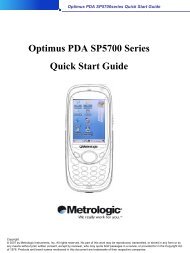
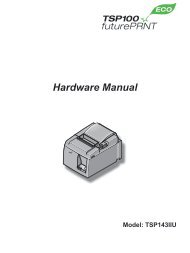

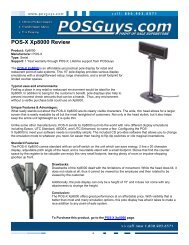
![MC9190-G Quick Start Guide [Spanish] (P/N 72-139206-01ES Rev. A)](https://img.yumpu.com/50178248/1/178x260/mc9190-g-quick-start-guide-spanish-p-n-72-139206-01es-rev-a.jpg?quality=85)

